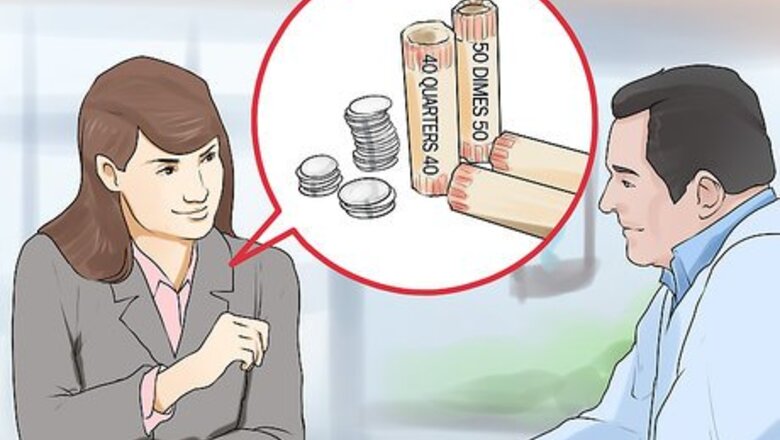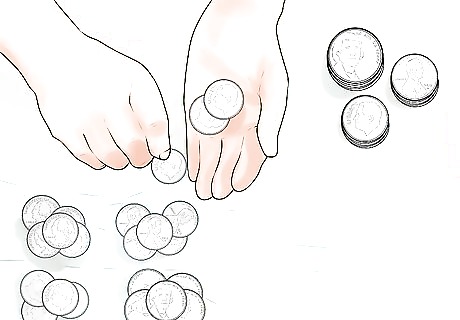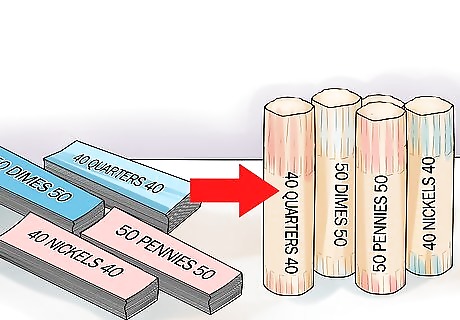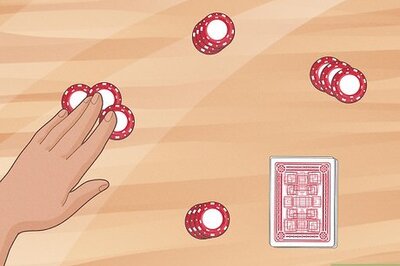
views
You may be looking for an article on rolling a coin over your knuckles.
Rolling Coins

If you plan to deposit the coins, first ask your bank for its requirements. Each bank develops its own policies for dealing with coinage. Your bank may only accept rolled coins, unrolled coins, or coins of a certain value. Ask a bank teller over the phone or in person before you start sorting your coins, to avoid wasting time on coins you won't be able to deposit.

Acquire coin wrappers. Banks usually give these cylindrical wrappers out for free, at least in the United States and in countries that use the euro as currency, and they are also available for purchase at some supermarkets. The wrappers may be made out of paper or transparent plastic, and come in a different size for each type of coin. These wrappers are usually labeled with the name of the coin, but there may be a color-coded system as well. For instance, in the United States, red wrappers are for pennies, blue for nickels, green for dimes, and orange for quarters.

Separate your coins into different types. Gather your change and separate the coins by type. You can keep the different coins in rough piles for now; there is no need to stack them or count them yet. If you have a large amount of mixed coins, you may prefer to look at the section on other methods for information on coin-sorting machines.

Lay out the coins of one type onto a bed or other soft surface. Take your newly separated coins of one type, such as nickels or 20 euro-cent coins, and place them on a flat surface cleared of other objects. Spread them out with your hands until they form a single layer of coins. A freshly made bed, a comforter stretched over a coffee table, or a similar soft surface makes it easy to pick up the coins, and to keep piles of coins separated in their own "dents" in the material.

Separate the coins into piles of ten coins. Work with both hands at once, counting to ten as you pick up one coin in each hand. Once you have ten coins in each hand, place each group of ten coins in its own separate pile. As you keep doing this, the task should become easier and faster. You may be tempted to stack the coins instead of making piles, but this is usually a waste of time, since the stacks often fall over.

Push open the wrappers. Unfold one end of each wrapper if necessary. Some wrappers are sold as open tubes, in which case you can skip this step. As with any task, this becomes faster with repetition. Opening all your wrappers at once will be faster than opening one, filling it with coins, opening the next, etc.

Check how many coins there are per roll. Each wrapped roll of coins contains a certain number of coins, depending on the wrapper. You can calculate this based on the value printed on the wrapper, or refer to the following list: Each U.S. roll contains 50 pennies, 40 nickels, 50 dimes, or 40 quarters. Each euro roll contains 50 one-cent, two-cent, or five-cent coins; 40 ten-cent, twenty-cent, or fifty-cent coins; or 25 one-euro or two-euro coins.

Pick up enough piles to make one roll. For example, if you are picking up pennies, pick up five piles of ten pennies each, since 5 x 10 = 50. If you are rolling one-euro or two-euro coins, you'll need to pick up 2½ piles, or two full piles (twenty coins total) and half of another pile (five coins). If you have small hands, you may need to pick up a smaller amount of coins and fill each roll in sections.

Arrange the handful of coins into a cylinder shape. Shake the coins gently in your hand, while using your other hand to arrange them in a sideways stack. Once finished, the coins will be standing on their edge, running in a line from your palm to your cupped fingertips. When you're rolling coins for the first time, make the cylinder of coins as even as possible, to make it easy to get the coins in the paper or plastic wrapper. As you practice this, you'll be able to work faster and make looser cylinders.

Pour the coins into a wrapper. If the wrapper is open on both ends, stick a finger from your other hand into one end of the wrapper, up to the first joint, to block it off. Then tilt your hand down toward the other open end, letting the coins slide down into the wrapper. If the coins get stuck or fall out over the wrapper, slide all the coins out and repeat the process. This will happen less and less often as you practice.

Fold the open ends of the wrapper. Place a finger on each end of the filled wrapper and move the coins from side to side until there is an equal amount of space on each end. Fold down each end of the wrapper to form a closed end. For flat coin wrappers, fold the two creased edges down over the coin, then fold the two remaining points down over them. Repeat with the other side.

Repeat for your remaining coins. Pick up another pile, form it into a stack, and pour it into the next wrapper. As you continue, you'll find this process getting easier and more automatic, allowing you to simultaneously hold a conversation, listen to a podcast, or perform some other task that doesn't use your hands.
Using Other Methods to Sort or Measure Coins

Use a coin-counting machine at a supermarket or your bank. Many large stores have coin-counting machines, which rapidly count inserted mixed coins and returns paper money. However, these usually charge you a percentage of your total coin value as a fee, or gives you full value only in the form of a gift certificate to certain retailers. Certain banks have similar services, but usually only for customers. In Canada or the eastern U.S., even non-customers can use the coin-counting machines at BMO (Bank of Montreal) or TD Bank, although there may be fees. Find the nearest location of a BMO coin-counting service here.

Buy a coin-sorting machine. Coin-sorting machines for home use separate coins of different types into their own stack, or even into prepared paper wrappers. These range from a stack of cheap plastic trays with different sized holes, to machines that cost several hundred dollars or euros, and sort the machine in fast or visually appealing ways. Cheap, electronic coin-counting machines may jam after a few uses. Look for reviews online before buying one.

Measure your change collection's value by weight. Because coins are minted with a precise size and composition of metals, each one weighs a certain, predictable amount. You can estimate the value of a mixed coin collection using CoinCalc.com or for U.S. coinage, or separate them by type and weight them for a more accurate result: One pound of quarters is worth $20. One pound of dimes is worth $20. One pound of nickels is worth about $4.50, and one pound of pennies is worth about $1.80. One kilogram of two-euro coins is worth about €235. One kilo of one-euro coins is worth about €133. One kilo of 50-cent euro coins is worth about €64. A kilo of 20-cent coins is worth about €35, a kilo of 10-cent coins is worth about €24, a kilo of 5-cent coins is worth about €13, a kilo of two-cent coins is worth about €6.67, and a kilo of one-cent coins is worth about €4.35. In the United Kingdom, banks will weigh bags of coins for you.




















Comments
0 comment